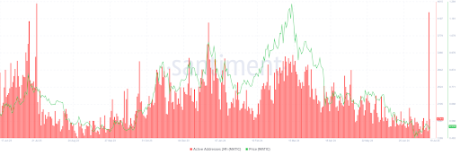Polygon Network Active Addresses Just Hit A New Yearly High, But Why Is MATIC Price Down?

Polygon (MATIC) appears to be underperforming compared to the broader market, where most of the attention is directed toward other major cryptocurrencies with larger market caps. Despite this subdued price movement, the Polygon network recently experienced a significant surge in activity, reaching its highest levels in over a year. This notable increase in activity is largely attributed to recent announcements concerning the migration of Polygon’s MATIC token to the new POL tokens.
Polygon Network Activity Hits Yearly High
According to on-chain data from Santiment, the participation of addresses on the Polygon network surged dramatically following the announcement of the token migration. This increase was highlighted by Santiment’s Active Addresses 24-hour metric, which tracks the number of network addresses that either sent or received transactions within a 24-hour period. Remarkably, this spike in activity propelled the metric to exceed 4,200 addresses over the weekend.
A deeper analysis of the on-chain data reveals that this surge represents a significant departure from the previous trend. Daily activity has been on a steady decline since March. In fact, the day before the spike, the Active Addresses metric recorded fewer than 1,500 active addresses. This sharp rise underscores the impact of the token migration news, indicating a renewed interest and engagement among some participants of the Polygon network, which contrasts sharply with the earlier downward trend in activity.

MATIC Price Analysis
At the time of writing, Polygon (MATIC) is trading at $0.534. The cryptocurrency is currently contending with a resistance level of around $0.55, a barrier that the bulls have been unable to overcome in the past 24 hours. This resistance emerged following a bullish price movement from a yearly low of $0.4313 that kickstarted on July 6, representing a 27.5% increase up to the $0.55 mark.
Looking at a broader timeframe reveals that this price point has consistently posed a strong resistance level ranging up to $0.57. MATIC has made many attempts to break past this level since the last week of June. According to data from IntoTheBlock, there are currently 19,450 addresses holding a total of 454.38 million MATIC tokens at an average price of $0.57. This concentration of holdings around the $0.57 price level likely explains the resistance, as many addresses might be likely selling after moving into profitability, thereby exerting downward pressure on the price.
MATIC’s profitability count is currently the lowest among major cryptocurrencies, with only 30,100 addresses in profit. This figure represents less than 5% of the total addresses holding MATIC. However, this could change very soon after the mainnet upgrade.

The mainnet upgrade from MATIC to POL is slated to take place in September. The anticipation surrounding this event could generate significant buying pressure for MATIC, potentially improving holder profitability.
WazirX Moves To Recover $150 Million In Shiba Inu, Ethereum And Others With Bounty Program

Following a hack attack that resulted in the theft of millions of dollars worth of Shiba Inu (SHIB), Ethereum (ETH) and other coins, WazirX has launched an official bounty program. The prominent Indian exchange has promised to reward anyone who assists in recovering the stolen assets.
WazirX Announces Bounty Program To Recover Assets
WazirX has announced via its official X (formerly Twitter) account that it has launched a bounty program in response to the recent cyberattack on one of its Multisig wallets. The team behind the Indian exchange revealed that the bounty program will be focused on recovering the stolen assets from malicious actors.
On July 18, WazirX was hacked by malicious actors who stole $234.9 million worth of ETH, PEPE, USDT and other cryptocurrencies from the exchange. The hack attack also saw over $100 million worth of SHIB tokens swiped from the exchange’s safe Multisig wallet.
Initially, Nischal Shetty, co-founder of WazirX, disclosed on July 21 that the exchange would offer $11.5 million in rewards for recovering the stolen funds. However, the WazirX team later revised the bounty, increasing it to up to 10% of the stolen assets, which amounts to $23 million.
The Indian exchange has invited hat hackers, cybersecurity professionals, and blockchain forensics experts from around the world to join the bounty program and protect the integrity of the crypto ecosystem. Via an official blog post, WazirX also delved deeper into the details of the bounty program and its reward allocation.
According to the exchange, there are two bounties within the program. The first bounty will offer up to $10,000 worth of USDT to participants. The requirement for this bounty is to identify, track and provide actionable intelligence that could help WazirX or the participant freeze the exploited funds.
The second bounty involves facilitating the recovery of the stolen assets. WazirX has stated that the participants who successfully recover the assets will be awarded 10% of the total amount as a white hat incentive. The reward will also be paid in USDT or the form of the recovered funds at the sole discretion of WazirX.
Requirements For The WazirX Bounty Program
In its blog post, WazirX noted the time frame for the bounty program, highlighting that it will run for three months, starting from the day of the announcement. This time frame is subject to change and can be extended or reduced with or without notice of the participants involved in the program.
Furthermore, the exchange provided a list of eligibility requirements to join the program. WazirX disclosed that the bounty program is open to everyone, excluding current and former employees of WazirX and their immediate family members. Additionally, participants of the bounty program are mandated to submit detailed information on their tracking methods and ensure that all submitted information remains confidential.

